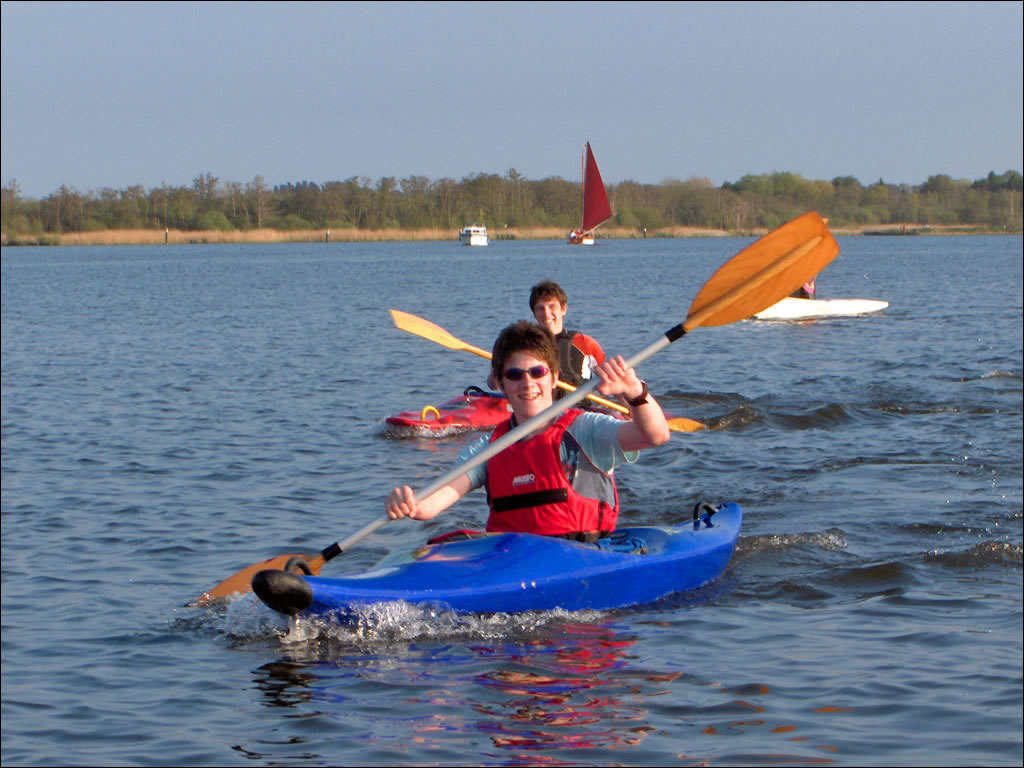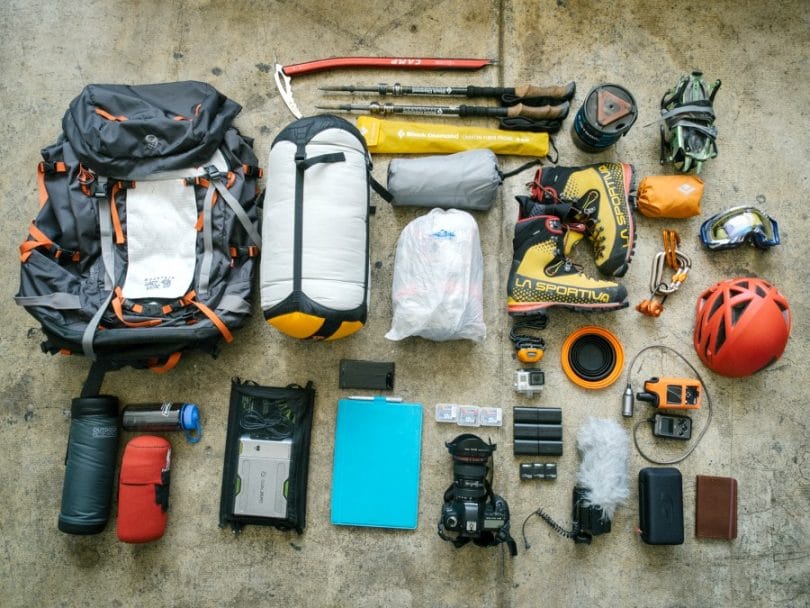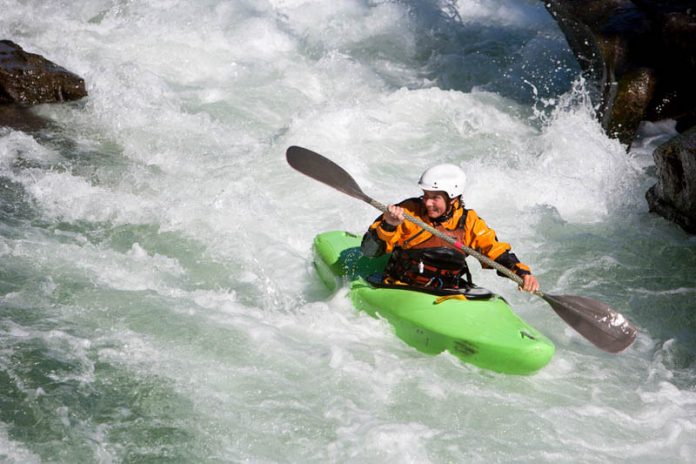Having a fun and safe experience on the water begins with preparation. Dependent upon the weather conditions and how cold the water is, having the right clothing is essential. All kayakers, no matter how skilled, risk the possibility of an unexpected capsizing and may have to spend some time in the water or paddling when wet. Dressing and packing with emergency situations in mind will ensure that paddlers stay safe in all kinds of conditions.
Dressing For the Weather
Protection from the sun: Lightweight, long-sleeved shirts and pants provide great sun protection. Synthetic fabrics that are quick drying are ideal. Whatever kayakers wear should not get heavy when soaked. Sunglasses, a hat and waterproof sunscreen should be considered mandatory. Always remember to drink plenty of fluids when the weather is hot to prevent dehydration and heat stroke.
Protection from the wind: The effects of the wind are much more pronounced out on the water. Carry a waterproof jacket designed for splash and rain protection. A windproof top plus at least one thermal layer is ideal.
Protection from the rain: Paddling in the rain can actually be pleasant, if prepared. On the other hand it can be absolutely miserable. Always pack a waterproof jacket and thermal layers, made of synthetic fabrics such as polypropylene or nylon. A woolen hat or a hood on the jacket will reduce the heat loss from the head and also will stop water from running down the face, which becomes uncomfortable and inhibits vision.
Protection from the cold: In very cold air or water, the key is to dress to be both warm and dry. Dress in layers using clothing made of synthetic fabrics such as neoprene or polyester fleece. Carry extra clothing in cold weather and store it in a waterproof container. A wetsuit or dry suit will help prevent hypothermia. Gloves or mitts on the hands will prevent the pain of wet, cold fingers.
Lifejackets

A personal flotation device (PFD) or lifejacket is essential for a safe paddling trip. A PFD should fit snugly and allow comfortable floating. It should fit well enough so that it does not get pulled up and off in the water. The wearer should be able to wave his or her arms around freely. An added safety feature would be to fasten a whistle to the lifejacket.
Headwear
Helmets are not required safety gear, however, some whitewater conditions make them necessary. In cold weather, a synthetic hat or skullcap can help to prevent heat loss. In hot weather, a hat with a bill or wide brim will help shield the head and face from the sun.
Footwear
Heavy, cumbersome footwear is not ideal for paddling. Most paddlers opt for old tennis shoes but sometimes the rubber soles stick or jam inside the boat. Also, be careful with anything that has laces, that they don’t catch in or on the kayak. In most environments it is wise to wear something on the feet, even if just to protect the feet from sharp rocks or shells when launching. Special water shoes are a good choice as they have non-slip soles and are padded and reinforced. In cold weather or cold water, neoprene booties are the best option.
Kayakers are generally more exposed to the elements out on the water than they are on land. It is necessary to take precautions since the effects of heat and cold and weather changes can strike very suddenly. Make sure to be equipped for all weather conditions before setting out for a day on the water for the enjoyment of all.
Essential Kayaking Gear and Supplies
People paddle for a wide variety of reasons. Having a fun and safe experience on the water requires that kayakers have the proper clothing and equipment specific to the type of activity, paddling destination, length of trip and regulations. Some or all of this equipment may be required, so always check state and federal laws and make sure to know how to use the equipment prior to kayaking.
Essential Kayaking Gear and Supplies

Personal Flotation Device (PFD): The PFD is the most important piece of safety equipment and should be worn at all times. They should fit snugly and allow for floating comfortably.
Water Bottle: Always remember to drink plenty of water to stay hydrated, especially on warm weather days.
Snacks: Food can provide much needed energy when tired or hungry after a long paddle.
Sponge or Bilge Pump: Any type of sit-in kayak may start to accumulate water. Sponges and pumps can be used to remove the water, making the boat lighter and the paddler more comfortable.
Rope: A tow rope, or towline, is used to help pull a tired or hurt paddler in emergency rescue situations. They are worn around the waist or PFD, can be short or long and should be buoyant.
Whistle or Horn: Most regulations require that whistles be tied to a PFD. The loud noise can alert others if help is needed. A series of three, short powerful blasts signals an emergency. A single blast is used to draw attention.
Dry Bag: Dry bags provide watertight storage for extra clothing, food, cameras, cell phones and other equipment and supplies.
Insect Repellant: Waterproof repellant will help protect against mosquitoes and other biting insects that inhabit water areas.
Sunscreen: Sunburn is a serious risk out on the open water. Use a waterproof sunscreen with an SPF of 30 or higher and reapply often for the best protection.
First-aid Kit: A first-aid kit should be standard gear on any kayak trip. A basic kit can be modified to the trip and the health consideration of participants.
Spare Paddle: At least one member of the group should carry an extra paddle in case someone loses or breaks their paddle. There are also paddle leashes available that clip paddles to the inside of the kayak to ensure they don’t float away.
Light: Paddlers who are out at dawn or dusk will need to bring some type of light. A headlamp leaves the hands free to paddle and allows the kayakers to see where they are going as well as enabling others to see the paddler.
Maintaining Paddling Gear
To prevent gear from getting damaged by repeated exposure to sun and water it is important to keep it clean. Rinse thoroughly after usage, especially when used in salt water. Protect the gear from extreme heat and store in a cool, dry location. If gear does become worn or damaged, replace it immediately: the equipment won’t help you if it breaks.
Additional gear commonly used by paddlers include: a compass or GPS, maps or nautical charts, two-way radios, spray skirt, and flares. Always know the characteristics of the waterway and the weather before launching and have the proper gear and supplies on hand in case of any type of emergency. This preparation will make a big difference in the outcome of the trip and the enjoyment of the paddlers.




